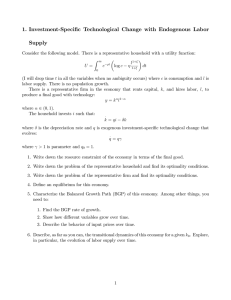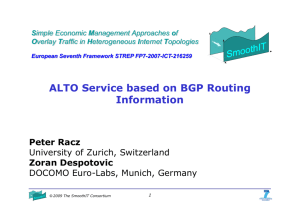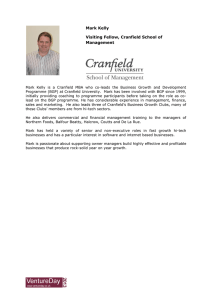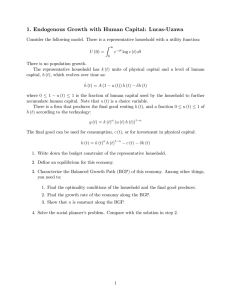BGP Course Proposal Worksheet
advertisement
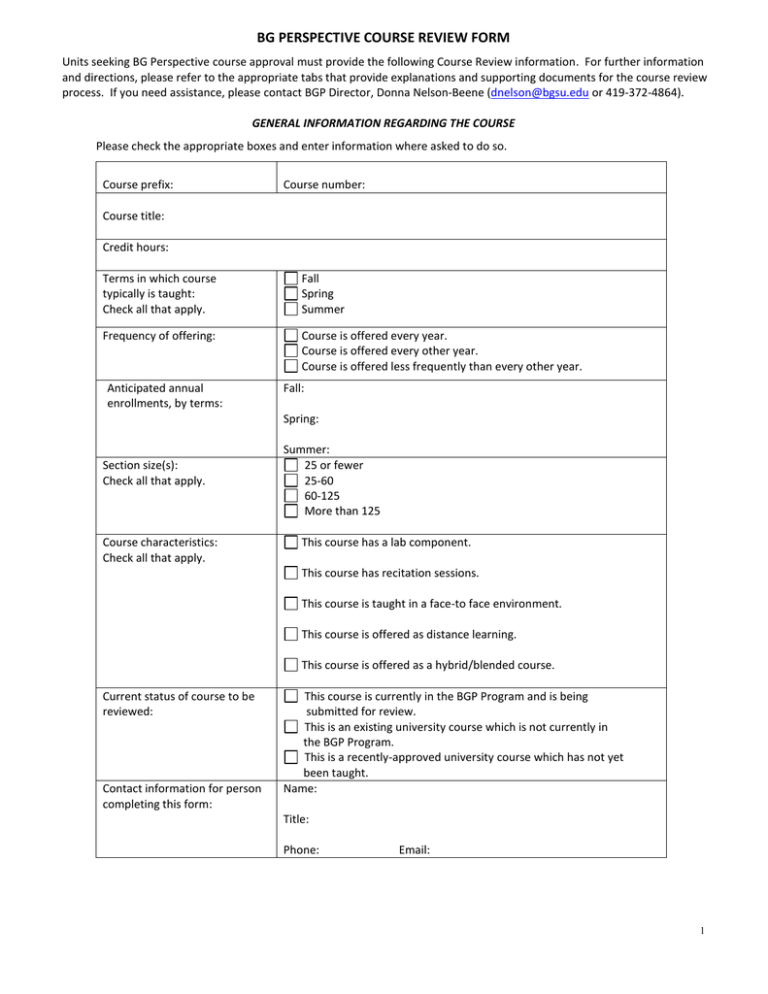
BG PERSPECTIVE COURSE REVIEW FORM Units seeking BG Perspective course approval must provide the following Course Review information. For further information and directions, please refer to the appropriate tabs that provide explanations and supporting documents for the course review process. If you need assistance, please contact BGP Director, Donna Nelson-Beene (dnelson@bgsu.edu or 419-372-4864). GENERAL INFORMATION REGARDING THE COURSE Please check the appropriate boxes and enter information where asked to do so. Course prefix: Course number: Course title: Credit hours: Terms in which course typically is taught: Check all that apply. Fall Spring Summer Frequency of offering: Course is offered every year. Course is offered every other year. Course is offered less frequently than every other year. Anticipated annual enrollments, by terms: Fall: Spring: Section size(s): Check all that apply. Course characteristics: Check all that apply. Summer: 25 or fewer 25-60 60-125 More than 125 This course has a lab component. This course has recitation sessions. This course is taught in a face-to face environment. This course is offered as distance learning. This course is offered as a hybrid/blended course. Current status of course to be reviewed: Contact information for person completing this form: This course is currently in the BGP Program and is being submitted for review. This is an existing university course which is not currently in the BGP Program. This is a recently-approved university course which has not yet been taught. Name: Title: Phone: Email: 1 COMPONENTS TO BE SUBMITTED FOR BG PERSPECTIVE COURSE REVIEW A. Course description. Please provide the catalog description for the course. B. Interactive Engagement Activities. Please provide an explanation of the in-class and out-of-class interactive engagement activities which contribute to student learning in this course. C. Master Syllabus. Please attach a detailed master syllabus for this course. The master syllabus is the document that provides the framework from which individual faculty members will build the syllabus for their own sections of the course. Faculty should include the components of the master syllabus in their own course syllabus, but they are encouraged to customize the document to their own instructional purposes. There should be one master syllabus for each course, and it should contain the following components: Course aim Student course learning outcomes/BG Perspective student learning outcomes Topics covered Instructional strategies Student learning activities Methods used for determining grades An explanation of how each learning outcome will be assessed in the course Kinds of assignments and as much detail as possible about each of these assignments. If desired, assignment sheets may be attached to the syllabus Examples of instructional materials such as textbooks, internet websites, electronic media, videos, films, recordings, and/or exhibitions Example of a calendar showing the topics and activities to be covered in the course Course policy statements 2 ASSESSMENT COMPONENT OF BG PERSPECTIVE COURSE REVIEW Need for a Plan to Assess BGP Outcomes: The mission of the BG Perspective course review process is to ensure that each BGP course will be taught with effective learning strategies; that pedagogical decisions will be guided by evidence of student learning; and that each BGP course will contribute to providing students with an excellent foundation for moving into upperlevel courses. To this end, it is essential for academic units to have a coherent and integrated plan in place for measuring student learning. Careful alignment of course assignments with BGP outcomes—and a subsequent assessment process—will help units address and assess BGP expectations for student learning in each BGP course they offer. During the course review process, the BGP Committee will give serious attention to these plans. BGP Assessment Data Submission: Ongoing, routine measurements of students’ success in achieving learning outcomes is essential in today’s culture of assessment. Future re-accreditation evaluations, in fact, will require BGSU to submit evidence regarding the quality of student learning in our general education courses to HLC (Higher Learning Commission). With this mandate in mind, academic units will need to maintain—and provide upon request—concrete data regarding their BGP assessment results. Academic units will submit their assessment data to the Office of Academic Assessment (assessment@bgsu.edu), which has been created to oversee assessment at BGSU as well as to provide assessment guidance and assistance to faculty and academic units. Details about the process for data submission will be provided at a later date. Please note that in many cases the assignments already being given in classes will be able to be used for these assessments. Because the submission of assessment data regarding BGP’s Student Learning Outcomes has become so important, the timely submission of requested data will be necessary for continued BGP course approval. Learning Outcomes Charts: The “domain charts” which follow this section have been created to help units consider the assignment(s) they will use for addressing the BGP Learning Outcomes and assessing the degree to which the outcomes are met. Please provide the requested information within the chart(s) which apply to domain(s) of the course that is being submitted for review. Note that one assignment may be used to address multiple outcomes. BGP Outcomes that Must be Addressed: The expectation is for a course to address all of the BGP outcomes established for the domain. However, on occasion an outcome may not be appropriate for a given course. If an established outcome is not appropriate for the course being submitted for review, a rationale must be provided for eliminating it. No more than one outcome may be eliminated from a domain, however. 3 ENGLISH COMPOSITION AND ORAL COMMUNICATION A. Directions for Completing Assignment(s)/Assessment Chart: The chart below must be completed for courses in the English Composition and Oral Communication domain. Please provide the information that is requested for each BGP Student Learning Outcome, taking care to provide as much detail as necessary to convey your meaning clearly; the textboxes are expandable. Specifically, please provide information about the following: • Assignment(s) used to help students achieve BGP’s student learning outcomes established for the domain. (Note: It is possible for one assignment to address multiple outcomes.) Methods used to assess the outcomes (e.g., applying a rubric to a paper, a project, or e-portfolio artifacts; creating a table of specifications/content analysis for quizzes and exams; administering a standardized instrument; using calibrated peer review, etc.). BGP Student Learning Outcomes ☐ ☐ ☐ ☐ ☐ ☐ Class activities/assignment(s) that address the BGP outcome Methods of assessment ECOC1. Formulate effective written and/or oral arguments which are based upon appropriate, credible research. ECOC2. Construct materials which respond effectively to the needs of a variety of audiences, with an emphasis upon academic audiences. ECOC3. Analyze how the principles of rhetoric work together to promote effective communication. ECOC4. Communicate effectively when participating in small groups and/or making formal presentations. ECOC5. Utilize rhetorical strategies that are well-suited to the rhetorical situation, including appropriate voice, tone, and levels of formality. ECOC6. Demonstrate critical thinking, reading, and writing strategies when crafting arguments that synthesize multiple points of view. B. Elimination of an Outcome: The expectation is for a course to address all of the outcomes established for the domain. However, on occasion, one of the outcomes may not be appropriate for a given course. If one of the established outcomes is not appropriate for your course, please provide your rationale for eliminating it. Please note that no more than one outcome may be eliminated. Outcome not addressed: Rationale for eliminating it: C. Please attach the documents and tools which have been created for assessing the BGP outcomes for this domain (e.g., assignment materials with accompanying rubric, standardized instruments, reflection activities, pre-post tests, etc.). D. Assessment Data Collection: Please explain how BGP outcome assessment data will be gathered and where it will be stored. 4 QUANTITATIVE LITERACY A. Directions for Completing Assignment(s)/Assessment Chart: The chart below must be completed for courses in the Quantitative Literacy domain. Please provide the information that is requested for each BGP Student Learning Outcome, taking care to provide as much detail as necessary to convey your meaning clearly; the textboxes are expandable. Specifically, please provide information about the following: • Assignment(s) used to help students achieve BGP’s student learning outcomes established for the domain. (Note: It is possible for one assignment to address multiple outcomes.) • Methods used to assess the outcomes (e.g., applying a rubric to a paper, a project, or e-portfolio artifacts; creating a table of specifications/content analysis for quizzes and exams; administering a standardized instrument; using calibrated peer review, etc.). BGP Student Learning Outcomes ☐ ☐ ☐ ☐ ☐ Class activities/assignment(s) that address the BGP outcome Methods for assessment QL1. Interpret mathematical and statistical models such as formulas, graphs, tables, and schematics, and draw inferences from them QL2. Represent mathematical and statistical information symbolically, visually, numerically, and verbally QL3. Use arithmetical, algebraic, geometric and statistical methods to solve problems QL4. Estimate and check answers to mathematical problems in order to determine reasonableness, identify alternatives, and select optimal results QL5. Recognize that mathematical and statistical methods are based on assumptions and have limits B. Elimination of an Outcome: The expectation is for a course to address all of the outcomes established for the domain. However, on occasion, one of the outcomes may not be appropriate for a given course. If one of the established outcomes is not appropriate for your course, please provide your rationale for eliminating it. Please note that no more than one outcome may be eliminated. Outcome not addressed: Rationale for eliminating it: C. Please attach the documents and tools which have been created for assessing the BGP outcomes for this domain (e.g., assignment materials with accompanying rubric, standardized instruments, reflection activities, pre-post tests, etc.). D. Assessment Data Collection: Please explain how BGP outcome assessment data will be gathered and where it will be stored. 5 HUMANITIES AND THE ARTS A. Directions for Completing Assignment(s)/Assessment Chart: The chart below must be completed for courses in the Humanities and the Arts domain. Please provide the information that is requested for each BGP Student Learning Outcome, taking care to provide as much detail as necessary to convey your meaning clearly; the textboxes are expandable. Specifically, please provide information about the following: • Assignment(s) used to help students achieve BGP’s student learning outcomes established for the domain. (Note: It is possible for one assignment to address multiple outcomes.) • Methods used to assess the outcomes (e.g., applying a rubric to a paper, a project, or e-portfolio artifacts; creating a table of specifications/content analysis for quizzes and exams; administering a standardized instrument; using calibrated peer review, etc.). BGP Student Learning Outcomes ☐ ☐ ☐ ☐ Class Activities/ assignments that address the BGP outcome Methods for assessment H1. Apply humanistic modes of inquiry and interpretation in the illustration of the discipline’s connection to human values. HA2. Demonstrate a fundamental critical understanding of the role of arts, language, and/or media in culture and society. HA3. Examine how the social and cultural contexts of creative endeavors arise over a variety of historical periods. HA4. Illustrate the development of verbal and non-verbal communication in the humanities and/or the arts. B. Elimination of an Outcome: The expectation is for a course to address all of the outcomes established for the domain. However, on occasion, one of the outcomes may not be appropriate for a given course. If one of the established outcomes is not appropriate for your course, please provide your rationale for eliminating it. Please note that no more than one outcome may be eliminated. Outcome not addressed: Rationale for eliminating it: C. Please attach the documents and tools which have been created for assessing the BGP outcomes for this domain (e.g., assignment materials with accompanying rubric, standardized instruments, reflection activities, pre-post tests, etc.). D. Assessment Data Collection: Please explain how BGP outcome assessment data will be gathered and where it will be stored. 6 SOCIAL AND BEHAVIORAL SCIENCES A. Directions for Completing Assignment(s)/Assessment Chart: The chart below must be completed for courses in the Social and Behavioral Sciences domain. Please provide the information that is requested for each BGP Student Learning Outcome, taking care to provide as much detail as necessary to convey your meaning clearly; the textboxes are expandable. Specifically, please provide information about the following: • Assignment(s) used to help students achieve BGP’s student learning outcomes established for the domain. (Note: It is possible for one assignment to address multiple outcomes.) • Methods used to assess the outcomes (e.g., applying a rubric to a paper, a project, or e-portfolio artifacts; creating a table of specifications/content analysis for quizzes and exams; administering a standardized instrument; using calibrated peer review, etc.). BGP Student Learning Outcomes ☐ ☐ ☐ ☐ ☐ Class Activities/ assignments that address the BGP outcome Methods of assessment SBS1. Describe significant social/ behavioral issues/questions using appropriate theories and evidence. SBS2. Articulate how the values of the social/behavioral sciences impact decision-making in contemporary society. SBS3. Deconstruct social/behavioral arguments critically, refuting logical and reasoning flaws inherent in them. SBS4. Compose written or oral arguments related to issues or questions in the social/behavioral sciences. SBS5. Evaluate evidence supporting arguments and conclusions on each side of major social or behavioral issues. B. Elimination of an Outcome: The expectation is for a course to address all of the outcomes established for the domain. However, on occasion, one of the outcomes may not be appropriate for a given course. If one of the established outcomes is not appropriate for your course, please provide your rationale for eliminating it. Please note that no more than one outcome may be eliminated. Outcome not addressed: Rationale for eliminating it: C. Please attach the documents and tools which have been created for assessing the BGP outcomes for this domain (e.g., assignment materials with accompanying rubric, standardized instruments, reflection activities, pre-post tests, etc.). D. Assessment Data Collection: Please explain how BGP outcome assessment data will be gathered and where it will be stored. 7 NATURAL SCIENCES A. Directions for Completing Assignment(s)/Assessment Chart: The chart below must be completed for courses in the Natural Sciences domain. Please provide the information that is requested for each BGP Student Learning Outcome, taking care to provide as much detail as necessary to convey your meaning clearly; the textboxes are expandable. Specifically, please provide information about the following: • Assignment(s) used to help students achieve BGP’s student learning outcomes established for the domain. (Note: It is possible for one assignment to address multiple outcomes.) • Methods used to assess the outcomes (e.g., applying a rubric to a paper, a project, or e-portfolio artifacts; creating a table of specifications/content analysis for quizzes and exams; administering a standardized instrument; using calibrated peer review, etc.). BGP Student Learning Outcomes ☐ NS2. Identify misconceptions associated with the specific scientific discipline. ☐ NS3. Explain simple quantitative data and its limits relative to the study of science. ☐ ☐ Methods of assessment NS1. Describe how natural sciences can be used to explain and/or predict natural phenomena. ☐ ☐ Class Activities/ assignments that address the BGP outcome NS4. Demonstrate the application of simple quantitative and qualitative data in the scientific process. NS5. Solve problems using one or more of the logical approaches of science. NS6. Reflect on the relevance of science to one’s everyday life. B. Elimination of an Outcome: The expectation is for a course to address all of the outcomes established for the domain. However, on occasion, one of the outcomes may not be appropriate for a given course. If one of the established outcomes is not appropriate for your course, please provide your rationale for eliminating it. Please note that no more than one outcome may be eliminated. Outcome not addressed: Rationale for eliminating it: C. Please attach the documents and tools which have been created for assessing the BGP outcomes for this domain (e.g., assignment materials with accompanying rubric, standardized instruments, reflection activities, pre-post tests, etc.). D. Assessment Data Collection: Please explain how BGP outcome assessment data will be gathered and where it will be stored. 8 INTERNATIONAL PERSPECTIVE A. Directions for Completing Assignment(s)/Assessment Chart: The chart below must be completed for courses in the International Perspective domain. Please provide the information that is requested for each BGP Student Learning Outcome, taking care to provide as much detail as necessary to convey your meaning clearly; the textboxes are expandable. Specifically, please provide information about the following: • Assignment(s) used to help students achieve BGP’s student learning outcomes established for the domain. (Note: It is possible for one assignment to address multiple outcomes.) • Methods used to assess the outcomes (e.g., applying a rubric to a paper, a project, or e-portfolio artifacts; creating a table of specifications/content analysis for quizzes and exams; administering a standardized instrument; using calibrated peer review, etc.). BGP Student Learning Outcomes ☐ IP1. Explain how national cultures affect world views or ways of thinking. ☐ IP2. Explain how world issues and international connections impact people’s lives/ways of life. ☐ ☐ Class Activities/ assignments that address the BGP outcome Methods for assessment IP3. Analyze problems and possibilities inherent in global economic, geographic, ecological, political, social, and/or technological systems. IP4. Demonstrate competency in speaking, reading, and/or writing a foreign language. B. Elimination of an Outcome: The expectation is for a course to address all of the outcomes established for the domain. However, on occasion, one of the outcomes may not be appropriate for a given course. If one of the established outcomes is not appropriate for your course, please provide your rationale for eliminating it. Please note that no more than one outcome may be eliminated. Outcome not addressed: Rationale for eliminating it: C. Please attach the documents and tools which have been created for assessing the BGP outcomes for this domain (e.g., assignment materials with accompanying rubric, standardized instruments, reflection activities, pre-post tests, etc.). D. Assessment Data Collection: Please explain how BGP outcome assessment data will be gathered and where it will be stored. 9 CULTURAL DIVERSITY IN THE UNITED STATES A. Directions for Completing Assignment(s)/Assessment Chart: The chart below must be completed for courses in the Cultural Diversity domain. Please provide the information that is requested for each BGP Student Learning Outcome, taking care to provide as much detail as necessary to convey your meaning clearly; the textboxes are expandable. Specifically, please provide information about the following: • Assignment(s) used to help students achieve BGP’s student learning outcomes established for the domain. (Note: It is possible for one assignment to address multiple outcomes.) • Methods used to assess the outcomes (e.g., applying a rubric to a paper, a project, or e-portfolio artifacts; creating a table of specifications/content analysis for quizzes and exams; administering a standardized instrument; using calibrated peer review, etc.). BGP Student Learning Outcomes ☐ ☐ ☐ ☐ Class Activities/ assignments that address the BGP outcome Methods for assessment CDUS1. Recognize the ways in which diverse cultures or subcultures have shaped and continue to shape American life. CDUS2. Explain ways in which diverse cultures or subcultures have shaped and continue to shape American life. CDUS3. Examine issues and challenges in cultural diversity from the perspectives of diverse cultures. CDUS4. Compare values of their own subculture(s) with those of others. B. Elimination of an Outcome: The expectation is for a course to address all of the outcomes established for the domain. However, on occasion, one of the outcomes may not be appropriate for a given course. If one of the established outcomes is not appropriate for your course, please provide your rationale for eliminating it. Please note that no more than one outcome may be eliminated. Outcome not addressed: Rationale for eliminating it: C. Please attach the documents and tools which have been created for assessing the BGP outcomes for this domain (e.g., assignment materials with accompanying rubric, standardized instruments, reflection activities, pre-post tests, etc.). D. Assessment Data Collection: Please explain how BGP outcome assessment data will be gathered and where it will be stored. 10



